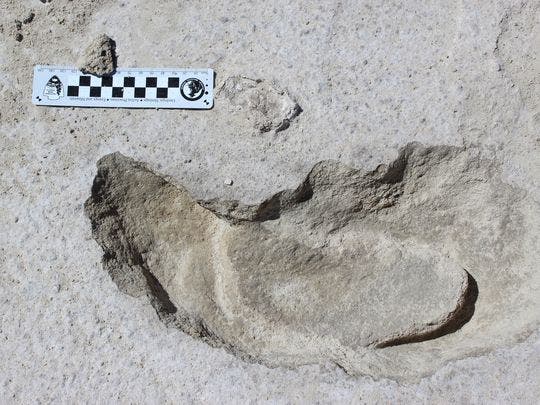An 11,000-year-old trackway still carries signs of an incredible encounter between human hunters and a mythological-like creature — the now-extinct giant ground sloth. This is the first evidence showing modern humans and giant sloths interacted directly. However, this was no friendly encounter.

David Bustos, of the National Park Service, had long suspected he’d be able to find fossilized footprints of ancient humans in New Mexico’s White Sands National Monument Park. The dry climate the area has had over the ages provides excellent opportunities for such fossils to be preserved in pristine conditions. Bustos and colleagues struck gold in April 2017, when they found giant sloth tracks — and inside these tracks, they found human footprints. Quite literally, the humans were following the footsteps of the sloth, which they most likely were looking to hunt for food.
Today, the six living species of sloths are usually found dangling from tree branches, or going viral on YouTube. But sloths used to be a lot more diverse—and a lot bigger. The largest giant sloth, called Megatherium, weighed several tons, reached 20 feet in length, and—when reared up on its hind legs—stood over 12 feet tall. That’s about the size of an elephant. However, the White Sands tracks were made by a much smaller ground sloth, either Nothrotheriops or Paramylodon.
Giant sloth footprints are easy to spot: they’re almost two feet long (30 cm) and a foot wide, shaped like kidneys, and show deep claw marks. In total, the researchers found 251 giant sloth tracks in White Sands from between 15,000 and 10,000 years ago.
The impressions left in the mud, which later become fossilized, suggest that the animal was 7-8 feet tall (up to 2.4 m) when standing on its rear legs. But even so, it would have been a formidable match for any pack of human hunters, with its tight muscles and Wolverine-like claws. According to Bustos who analyzed the fossilized foot, paw and claw marks left at the site, there was actually a standoff between the giant sloth, which reared up on its hind legs, and the humans who were hunting it.
“Human interactions with sloths are probably better interpreted in the context of stalking and/or hunting,” the researchers wrote in the study published in the journal Science Advances. “Sloths would have been formidable prey. Their strong arms and sharp claws gave them a lethal reach and clear advantage in close-quarter encounters.”

It’s not clear who won but chances have it that the humans, who were only equipped with stone weapons, likely didn’t make the kill. During those times, Bustos says that most human hunts ended in failure. Of course, the standoff might have never happened — instead, the humans might have followed the sloth trail an hour or so later after they were made. Without any butchered bones or artifacts, it’s quite anyone’s guess what happened here.
“The thing that is special about these prints and sets them apart from any other fossil trackways in the world is that this discovery records the interaction between humans and Ice age giant megafauna,” Bustos said. “White Sands National Monument has the largest concentration of human and Ice-age giant megafauna prints in the Americas.”
Beyond the breathtaking story it tells, the ancient trackway reveals how humans and giant ground sloths interacted at the end of the last ice age. The furry giants went extinct around this time, along with other iconic beasts, such as the mammoth and the North American horse. We know that the unforgiving climate made life very challenging for many of these ice age species but more and more evidence suggests humans took an active role in pursuing them. It’s likely that the sad fate of these species was sealed by a lethal combination of climate change and human hunting.
“At the end of the ice age, many of these animals became extinct,” Bennett said. “Were human hunters the cause of this extinction? The footprints at White Sands help us answer this question, by showing how ancient hunters stalked and attacked these fearsome animals.”






